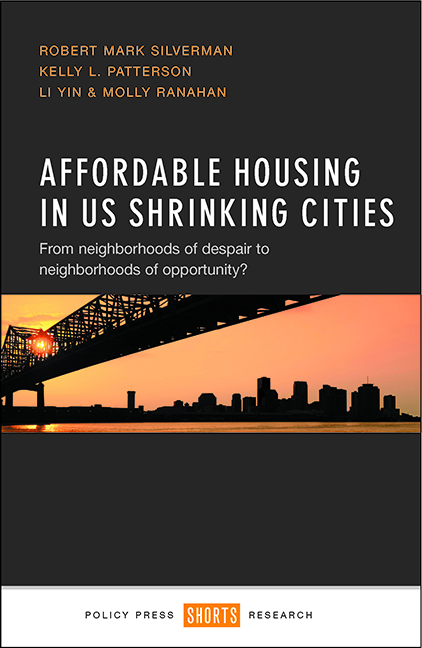 Affordable Housing in US Shrinking Cities
Affordable Housing in US Shrinking Cities Book contents
- Frontmatter
- Contents
- List of tables
- List of figures
- List of acronyms
- About the authors
- Acknowledgments
- Preface
- 1 Social equity and siting affordable housing in shrinking cities
- 2 Present-day Detroit
- 3 Present-day New Orleans
- 4 Present-day Cleveland
- 5 Present-day Pittsburgh
- 6 Present-day Buffalo, New York
- 7 Lessons learned and recommendations for siting affordable housing
- References
- Index
5 - Present-day Pittsburgh
Published online by Cambridge University Press: 01 September 2022
- Frontmatter
- Contents
- List of tables
- List of figures
- List of acronyms
- About the authors
- Acknowledgments
- Preface
- 1 Social equity and siting affordable housing in shrinking cities
- 2 Present-day Detroit
- 3 Present-day New Orleans
- 4 Present-day Cleveland
- 5 Present-day Pittsburgh
- 6 Present-day Buffalo, New York
- 7 Lessons learned and recommendations for siting affordable housing
- References
- Index
Summary
Introduction
This chapter examines Pittsburgh’s approach to urban revitalization. It begins with a discussion of the causes of the city’s population decline during the postwar period. This decline was rooted in structural shifts in the city’s traditional manufacturing base and emerging regional development patterns. This discussion highlights how Pittsburgh was somewhat unique among its peer shrinking cities, since it embarked on a relatively sustained effort to revitalize its downtown after the Second World War. A focus of these efforts was on redeveloping downtown as a mixed-use setting with commercial, retail, and cultural amenities. A relatively uncharacteristic component of Pittsburgh’s experience was the inclusion and an eds and meds strategy early in the postwar period. The discussion of the trajectory of urban revitalization in the city is followed by data presented to contextualize the city’s experience in a regional context. These data revealed that, despite sustained efforts to revitalize the core city, population loss was persistent in Pittsburgh. It is argued that urban revitalization stabilized the city’s civic center and adjacent university district, but these improvements did not have a noticeable impact on residents’ access to housing and institutional resources where revitalization occurred. This outcome was particularly noticeable with respect to low-income households with children.
After examining regional population and housing characteristics, the chapter then examines conditions in the area of Pittsburgh where eds and meds revitalization strategies have been adopted. The neighborhood characteristics where anchor-based strategies have been utilized are contrasted with the rest of the city. This analysis includes an examination of the composition of Department of Housing and Urban Development (HUD)-subsidized housing in areas slated for eds and meds revitalization. This focus is used in order to gain insights into the degree to which the preservation and expansion of affordable housing was factored into anchor-based revitalization strategies. This topic is explored in greater detail in the final section of the chapter.
Pittsburgh in the wake of sustained shrinking
Where things stand in Pittsburgh
Like other shrinking cities, Pittsburgh is the product of uneven development. Vitale (2015) describes how the process of uneven development has shaped the city in these terms:
For the past seventy years, a seemingly contradictory narrative has defined Pittsburgh. On one hand, Pittsburgh represents “Renaissance”: the ability of declining industrial regions to remake themselves into dynamic, “liveable” centers of the postindustrial economy.
- Type
- Chapter
- Information
- Affordable Housing in US Shrinking CitiesFrom Neighborhoods of Despair to Neighborhoods of Opportunity?, pp. 97 - 118Publisher: Bristol University PressPrint publication year: 2016


